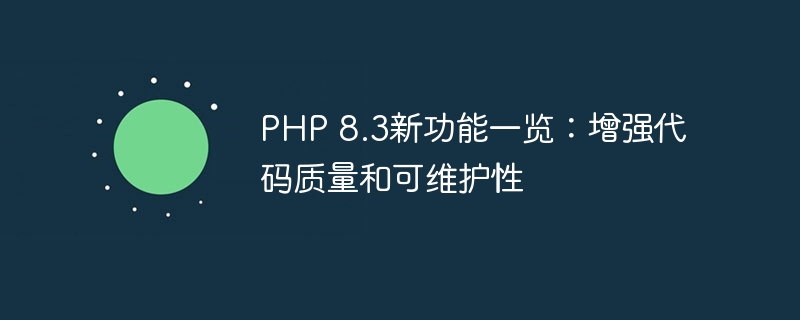

PHP is a widely used open source scripting language that is widely used in the field of web development. Since its release in 1995, PHP has continued to evolve and improve, with each version bringing new features and improvements. This year, PHP 8.3 version will bring a series of new features and improvements that will further enhance code quality and maintainability. This article will introduce some of the important features.
First, PHP 8.3 introduces a new feature that claims to reduce errors: named parameters. In the past, PHP functions could only pass parameters positionally, which often led to confusion and errors. Named parameters, on the other hand, allow passing by parameter name, which avoids confusion and makes the code clearer and easier to understand. For example, we can define a function like this:
function calculateDiscount($price, $percentage = 0.1) {
// 函数的代码
}Then, we can call the function like this:
calculateDiscount($price=100, $percentage=0.2);
By using named parameters, we can have a clearer understanding of the parameters passed to the function and avoid The problem of unclear parameter position.
Secondly, PHP 8.3 introduces a new error handling mechanism: non-local exceptions. In the past, when an exception was thrown, the program would immediately stop execution and jump to the exception handler. This can cause code logic problems in some cases, as the program may not execute to where expected. The non-local exception mechanism allows exceptions to be propagated to higher-level code, which allows for better control over exception handling. For example, we can use non-local exceptions like this:
function doProcess() {
// 执行一系列操作
if (somethingBadHappened()) {
throw new Exception('Something bad happened');
}
// 继续执行代码
}
try {
doProcess();
} catch (Exception $e) {
// 处理异常
}Through the non-local exception mechanism, we can handle exceptions at the appropriate place without having to stop the execution of the code.
Another important new feature is sandbox mode. PHP is a very flexible language, which means users can execute arbitrary code, including code that does not adhere to best practices. The sandbox mode can limit the user's code to only perform specific operations, thereby increasing the security of the code. For example, we can use sandbox mode like this:
$sandbox = new Sandbox();
$sandbox->execute('echo "Hello, World!"');Through sandbox mode, we can limit the permissions to execute code to prevent malicious operations.
In addition, PHP 8.3 also introduces some other features to enhance code quality and maintainability, such as namespace aliases, which allows the use of the as keyword to alias commonly used namespaces, making the code more readable; function signatures , the input and output of functions can be more clearly defined; attribute default values, default values can be specified in class attributes, reducing duplicate code; and some bug and performance optimizations. All these features will help improve the quality and maintainability of your code.
To summarize, PHP 8.3 brings a series of new features and improvements aimed at enhancing code quality and maintainability. These features include named parameters, non-local exceptions, sandbox mode, and more. By using these features, developers can write clearer, more reliable, and more secure code. Whether in an existing project or a new one, understanding and using these new capabilities will have a positive impact on the development process. Let’s look forward to the release of PHP 8.3 and start applying these new features as soon as possible!
The above is the detailed content of PHP 8.3 new features at a glance: enhanced code quality and maintainability. For more information, please follow other related articles on the PHP Chinese website!
 Digital currency trading app
Digital currency trading app
 Apple store cannot connect
Apple store cannot connect
 How to solve the 0x0000006b blue screen
How to solve the 0x0000006b blue screen
 Detailed explanation of Symbol class in JS
Detailed explanation of Symbol class in JS
 Is Yiouoky a legal software?
Is Yiouoky a legal software?
 Detailed explanation of Linux fork function
Detailed explanation of Linux fork function
 Solution to gmail being blocked
Solution to gmail being blocked
 How to solve the problem that Apple cannot download more than 200 files
How to solve the problem that Apple cannot download more than 200 files
 The difference between scilab and matlab
The difference between scilab and matlab




